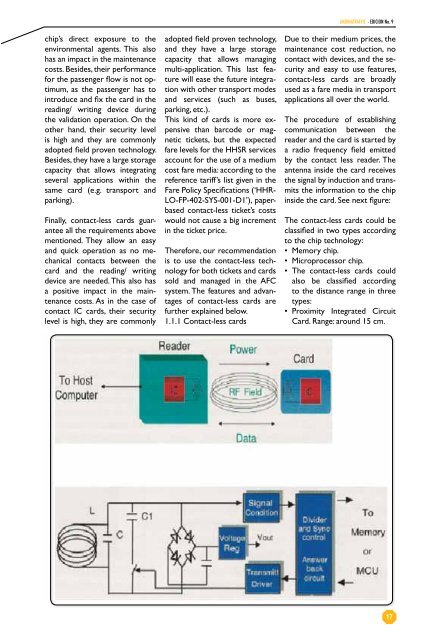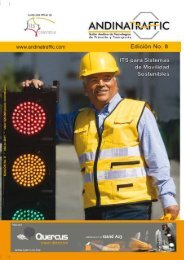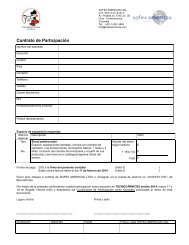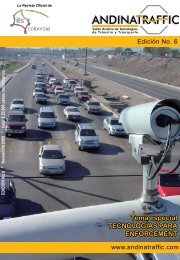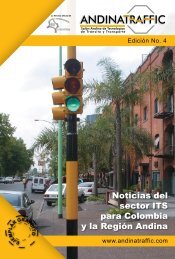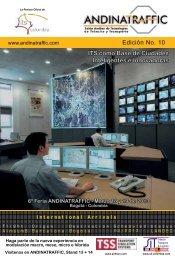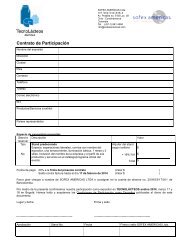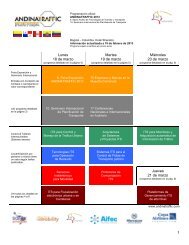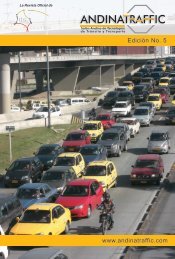Edición No. 9 - Andinatraffic
Edición No. 9 - Andinatraffic
Edición No. 9 - Andinatraffic
You also want an ePaper? Increase the reach of your titles
YUMPU automatically turns print PDFs into web optimized ePapers that Google loves.
chip’s direct exposure to the<br />
environmental agents. This also<br />
has an impact in the maintenance<br />
costs. Besides, their performance<br />
for the passenger flow is not optimum,<br />
as the passenger has to<br />
introduce and fix the card in the<br />
reading/ writing device during<br />
the validation operation. On the<br />
other hand, their security level<br />
is high and they are commonly<br />
adopted field proven technology.<br />
Besides, they have a large storage<br />
capacity that allows integrating<br />
several applications within the<br />
same card (e.g. transport and<br />
parking).<br />
Finally, contact-less cards guarantee<br />
all the requirements above<br />
mentioned. They allow an easy<br />
and quick operation as no mechanical<br />
contacts between the<br />
card and the reading/ writing<br />
device are needed. This also has<br />
a positive impact in the maintenance<br />
costs. As in the case of<br />
contact IC cards, their security<br />
level is high, they are commonly<br />
adopted field proven technology,<br />
and they have a large storage<br />
capacity that allows managing<br />
multi-application. This last feature<br />
will ease the future integration<br />
with other transport modes<br />
and services (such as buses,<br />
parking, etc.).<br />
This kind of cards is more expensive<br />
than barcode or magnetic<br />
tickets, but the expected<br />
fare levels for the HHSR services<br />
account for the use of a medium<br />
cost fare media: according to the<br />
reference tariff’s list given in the<br />
Fare Policy Specifications (‘HHR-<br />
LO-FP-402-SYS-001-D1’), paperbased<br />
contact-less ticket’s costs<br />
would not cause a big increment<br />
in the ticket price.<br />
Therefore, our recommendation<br />
is to use the contact-less technology<br />
for both tickets and cards<br />
sold and managed in the AFC<br />
system. The features and advantages<br />
of contact-less cards are<br />
further explained below.<br />
1.1.1 Contact-less cards<br />
ANDINATRAFFIC - EDICION <strong>No</strong>. 9<br />
Due to their medium prices, the<br />
maintenance cost reduction, no<br />
contact with devices, and the security<br />
and easy to use features,<br />
contact-less cards are broadly<br />
used as a fare media in transport<br />
applications all over the world.<br />
The procedure of establishing<br />
communication between the<br />
reader and the card is started by<br />
a radio frequency field emitted<br />
by the contact less reader. The<br />
antenna inside the card receives<br />
the signal by induction and transmits<br />
the information to the chip<br />
inside the card. See next figure:<br />
The contact-less cards could be<br />
classified in two types according<br />
to the chip technology:<br />
• Memory chip.<br />
• Microprocessor chip.<br />
• The contact-less cards could<br />
also be classified according<br />
to the distance range in three<br />
types:<br />
• Proximity Integrated Circuit<br />
Card. Range: around 15 cm.<br />
17


